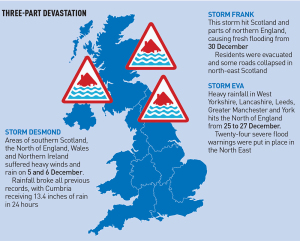Torrential storms in the North have cost the commercial property sector over £1bn. Now insurers, government and developers are rethinking their flood defence provisions

Picture the scene. It is Boxing Day morning and the memories of festive jollity are still fresh in your mind. Then you get a phone call from your managing director saying your land or property investment has been flooded. The damage is extensive.
That was the grim reality for a raft of industry executives across the UK as Storm Eva brought heavy rainfall to areas of West Yorkshire, Lancashire, Leeds, Greater Manchester and York over Christmas.
The total insurance bill from the commercial property industry for the December and January storms Desmond, Eva and Frank has been forecast by PwC to reach £500m-£700m.
It is a figure that PwC’s general insurance leader, Mohammad Khan, says reveals just how extensively these storms have hit the industry, compared with the UK’s most recent episodes of severe flooding in 2007, 2009 and 2014. A quick glance at the geography most recently affected makes it easy to see why.
The latest storms mainly caused rivers to break their banks in towns and cities, leading to the deluge of urban areas. In Leeds, the River Aire burst its banks, flooding sheds, housing and shops, including Land Securities’ Cardigan Fields leisure complex, which was temporarily closed. In York, the city centre saw “unprecedented” levels of rainfall, with all businesses evacuated and riverside pubs submerged.
This was in sharp contrast to the 2009 flooding episode in Cumbria, for example, where surface water flooded rural areas when rainwater failed to drain away through normal drainage systems.
Damage limitation
It may still be too early to fully assess the damage of an ongoing weather front that has more seriously caused the loss of human life and destroyed peoples’ homes. But when the water finally drains away, investors will be asking, could the industry have been better prepared? And what can be done to limit the damage from floods in the future?

So far the debate has centred on government funding and the Environment Agency chairman’s ill-timed Christmas holiday to Barbados (Sir Philip Dilley resigned this week). But those arguments are an “unhelpful distraction”, says Ian Joyner, associate director and head of flood risk at CBRE.
“We are kidding ourselves in the industry to say that there is ever going to be enough money to prevent all property from flooding. There is a wider picture of climate change. We seem to be having more of this extreme weather and the industry needs to look at what it can do.”
Joyner was appointed by CBRE in 2014 to a new role created specifically to deal with an increasing number of flood risk queries from clients.
He says that “understanding and awareness” about flood risks and flood damage mitigation should be the focus of the industry’s and government’s energies.
“There are always going to be political issues with regards to flood defence funding. While many in the industry would agree that flood defence spending has been cut [EA funding for maintaining flood assets has fallen by 14% since 2000, according to an Association of Drainage Authorities report] and the government could do more, even if the government did double the funding, it wouldn’t stop it [the flooding].
“Investors looking to invest in or develop land on flood plains need to have their own understanding of the risk and take their own measures to manage that risk.”
Taking simple steps, such as having a contingency plan in place so that if flooding is forecast, valuable building materials can be moved quickly, is one important step, he says.
“Knowing that everyone in the building is prepared and knows what needs to be done can mitigate the impact, some estimates say, by 20% to 80%,” says law firm Weightmans’ Sandra Jones, who has worked on flood insurance disputes for the past 17 years.
She advocates temporary flood barriers such as sandbags at the entrance to a property; changes to the interior of a building, such as replacing carpet with tiles; and moving expensive contents so they will be better protected, as ways to mitigate damage in properties at risk.
At what cost?
However, there are fears that any preventative measures won’t be enough to combat a potentially huge spike in insurance premiums for commercial property in flood-prone areas. A British Property Federation survey found that in some cases following the 2007 floods, premiums increased by as much as 500%.
“It’s still too early to judge what the actual impact is going to be,” says Khan of PwC. “Small businesses in areas where there has been repeated flooding may see their insurance premium rise by 400% to 500%. I think if you are in an area where there wasn’t damage from flooding, there may be an increase but it might not be in that order of magnitude.”
His advice for property owners is to find out if they are at risk, take steps to become more resilient and then shop around for the best deals.
“Climate change and the frequency of excess rainfall is going to increase, but that doesn’t mean people won’t be able to get insurance,” he says.
In April this year, the government will launch its home insurance initiative, FloodRe, which will cap annual premiums at £210 to £540 for homeowners in “high risk” areas. The scheme will cover 500,000 properties and will be funded through a levy of around £10.50 on all household premiums across the country. It will cover only properties built before 2009 and excludes leasehold flats, private rented homes and small businesses.
The BPF has previously campaigned for an extension of the scheme to the commercial property sector. But government subsidies and grants, some argue, can also lead developers to exacerbate the problem by building on inappropriate land.
“Providing insurance below the true costs of the risk insured leads to adverse site selection,” says Dieter Helm, professor of energy policy at New College, Oxford, in his report: Flood defence: Time for a radical rethink.
“Put another way, if new house owners faced the full cost of both flooding to themselves, and flooding risk increases to others, far more attention would be paid to the location of new housing.”
The Department for Environment, Food & Rural Affairs has committed £2.3bn to flood defence investment over the next six years – an increase of £1.7bn from the allocation of the last parliament.
Radical rethink
But Helm says the Environment Agency should instead invest in a “radical rethink” of what flood defence management looks like.
“The most important single step to be taken now is an explicit recognition that the status quo is not only unsustainable, but is never likely to be sustainable,” he says. “The worst reaction to the current floods crisis would be more of the same – a bit more emergency funding, and a bit larger EA budget.”
Instead, he suggests creating a “floods balance sheet” of flood defence assets and maintenance requirements in a similar way to utility companies’ practice, so that the EA could borrow against its assets. A flood levy for catchment areas should also be introduced, he argues, in addition to more localised flood management companies presided over by an overarching body.
Government policy around flood risk has moved forward since the 2007 floods overwhelmed parts of the country. The Pitt Review, a government-commissioned report prepared by Sir Michael Pitt in 2008, offered 92 recommendations to ensure the devastation was not repeated. Many of these have been implemented, including restrictions on building on flood plains and an overhaul of building requirements such as improved drainage facilities for homes built in flood-prone areas.
The government has now pledged to build 200,000 new starter homes by 2020. How will it avoid exacerbating the risk of flooding in the future by building on flood plains?
Joyner argues that the idea that new developments in flood-prone areas makes flooding worse is a “mischaracterisation”. If managed correctly, he says, measures such as sustainable drainage can actually help reduce the flood risk to the surrounding area.
Housebuilder Persimmon was faced with just that problem when its land in Germany Beck, York, with planning permission for 650 homes, became swamped at the start of the year, prompting calls from the parish council for a review of the scheme.
Simon Usher, deputy managing director at Persimmon Homes Yorkshire, argues that the development will alleviate flooding by using oversized drainage pipes to store run-off water that will then enter the Beck at a lower rate than it does from the neighbouring farmer’s field.
But it is likely to be an ongoing battle that will be replicated around the country between communities and developers, which, as the rain finally begins to slacken, are probably only just starting to think about how to contend with these problems.
“A lot of people were shut down over Christmas, flooded on Boxing Day, and are only just getting in touch,” says Joyner, who is preparing for a heavy workload in the next few months.
“The industry is certainly more aware but it is still playing catch-up.”











